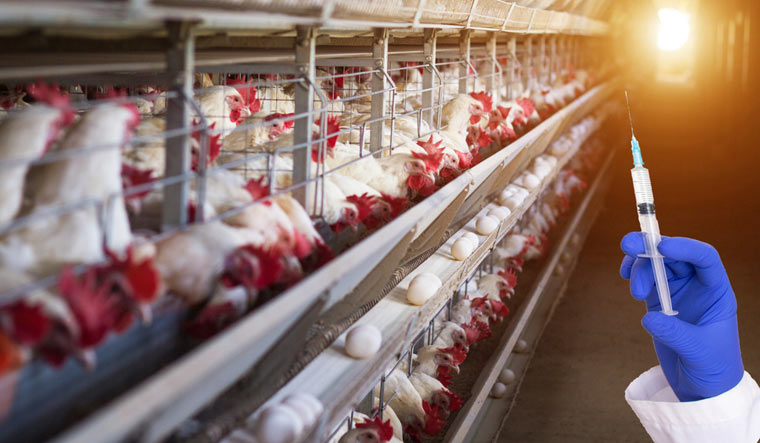As Antimicrobial resistance (AMR) rapidly takes root in India, it threatens to bring back the days when once-treatable diseases became life-threatening again. A recent study by the Indian Council of Medical Research (ICMR) lays bare the alarming rise in resistance to last-resort antibiotics. Among the many reasons for this spike in AMR, the excessive use of antimicrobials in various sectors, notably animal agriculture, is turning out to be a key factor.
Role of animal agriculture in AMR
The sprawling landscape of India's livestock farming is interspersed with practices that rely heavily on antibiotics. Often, these are not for disease treatment but for purposes such as growth promotion and mass prophylaxis. Antibiotics are frequently mixed into animal feed, targeting the gut directly, or are used in low doses, both of which provide conducive environments for resistance evolution.
India's penchant for poultry is backed by unsettling facts. The Centre for Science and the Environment has consistently highlighted the rampant use of antibiotics in India's chicken industry. In one of its reports, a cocktail of six prominent antibiotics, frequently used in poultry, was detected. The sheer volume of antibiotics funneled into the livestock is astounding. A global mapping exercise, led by Van Boeckel et al. estimated India's antibiotic consumption in livestock at a staggering 63,151 tons in 2010, projecting an alarming 67 per cent increase by 2030.
“On a factory farm, the presence of so many animals in close proximity creates a melting pot for disease, providing ‘Big Ag’ the opportunity to sell antibiotics and other pharmaceuticals to farmers,” said award-winning author and CEO of Compassion in World Farming, Philip Lymbery while taking about his book ‘Sixty Harvests Left: How to Reach a Nature-Friendly Future’. “It is no coincidence that 73 per cent of the world’s stock of antibiotics goes to farmed animals, largely to ward off diseases associated with intensive farming. The biggest six drug companies rely on the animal farming sector for $9 billion of sales each year,” he added.
The consequences of unchecked AMR are not distant but are being felt now. Europe witnesses 33,000 deaths annually due to antibiotic-resistant bacterial infections, with a significant percentage attributed to bacteria that resist even the last-line antibiotics. The United States paints a similar picture with over 35,000 deaths every year from such infections.
These statistics are merely the tip of the iceberg. A report by the UN Interagency Coordination Group on Antimicrobial Resistance postulates that by 2050, drug-resistant infections could lead to a harrowing 10 million deaths annually. Presently, the world sees a death toll of 7,00,000 every year due to drug-resistant infections.
To standardise AMR surveillance and develop strategies at all levels, the World Health Organisation introduced the Global Antimicrobial Resistance And Use Surveillance System (GLASS). The 2020 GLASS report presented a concerning pattern, revealing that only a third of AMR incidences occur in high-income countries. The bulk, two-thirds of these incidences, are concentrated in low and medium-income countries.
India's immediate crisis
Returning to the ICMR's findings, the diminishing efficacy of the antibiotic carbapenem stands out as a cautionary tale. As surgeries and other medical procedures risk becoming fatal endeavors in the absence of effective antibiotics, it's evident that India stands at a crossroads.
However, not all is lost. Andhra Pradesh provides a blueprint for a possible solution. Consider it as an approach where stakeholders across the board collaborated for a common goal: combating AMR. The programme’s mission was to address the misuse of antibiotics in AP's poultry and aquaculture sectors.
Through meticulous research, strategic stakeholder collaboration, and sustained government engagement, the stakeholders not only revealed the challenges but also galvanized consensus against using antibiotics as growth promoters. The integration of evidence-based research with community and governmental engagement laid the foundation for a transformative paradigm shift. By fostering agreement on antibiotic cessation and advocating for a dedicated 'One Health' cell, efforts like these shine as a beacon of hope. This holistic strategy underscores the value of collective action and stakeholder unity in steering agriculture towards sustainability, thereby addressing the AMR challenge head-on.
To circumvent the looming crisis, a critical reassessment of animal agriculture and its intertwined role in the rise of AMR in India is paramount. The integration of sustainable and responsible practices is more than a need – it is an imperative. As global networks become more interwoven, the call for sustainable practices reverberates beyond borders, underscoring that this is not solely India's challenge but a global responsibility.
(Varda Mehrotra is the founder of Samayu, a non-profit working for positive outcomes for people, planet and animals.
The opinions expressed in this article are those of the author's and do not purport to reflect the opinions or views of THE WEEK.)



